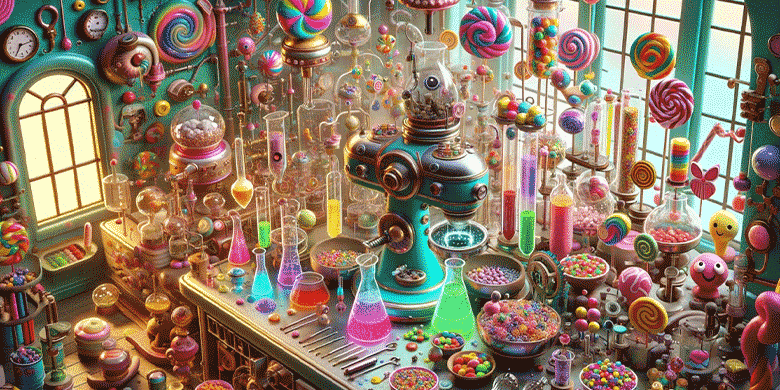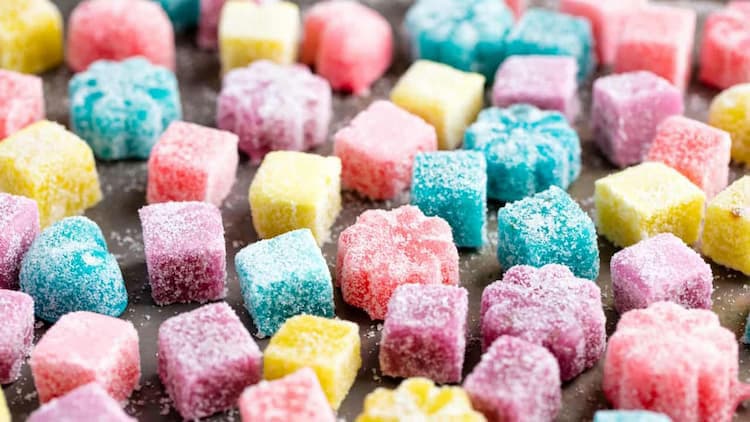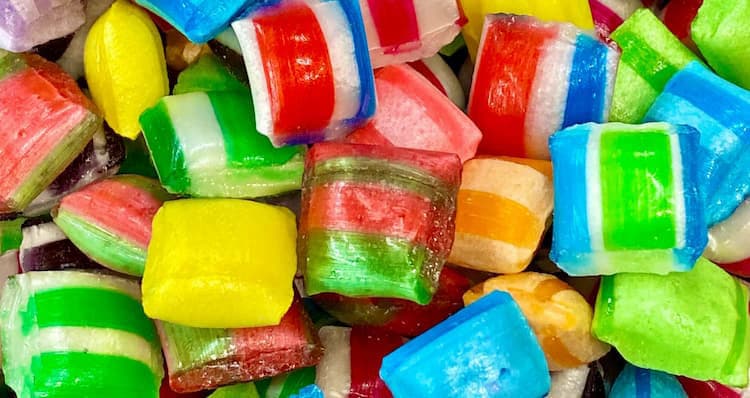
8 January, 2025
The Whimsical World of Confectionery: A Sweet Science!
Welcome to the enchanting universe of confectionery, where sugar and spice create everything nice, and where the alchemy of sweets turns ordinary ingredients into magical delights. Let's embark on a whimsical journey into the heart of sweet-making, where science meets fairy tale, and where every treat tells a story.
The Spellbinding Science of Sugar
In the world of confectionery, sugar is more than just a sweetener – it's a pivotal ingredient that orchestrates the texture, structure, and overall appeal of various sweet treats. It's a culinary chameleon, changing its form and function to create an array of confectioneries. Let's sprinkle some factual sugar and understand its scientific charm in the art of confectionery.
Sugar's Scientific Dance in Confectionery
Crystallization - The Architect of Texture: The science of sugar crystallization is fundamental in confectionery. For example, the size of sugar crystals is crucial in determining the texture of products like fudge and fondant. Fine crystals yield a smooth texture, as seen in creamy fudge, which typically contains about 30% sugar. Larger crystals result in a grainy texture, ideal for items like rock candy.
Caramelization - A Symphony of Flavours: When sugar is heated to around 170°C, it undergoes caramelization, a complex chemical process where sugar molecules break down and reform into compounds with deep, rich flavours and colours. This reaction is central to creating the alluring golden-brown hue and complex taste of caramel, a confection found in about 35% of all candy bars.
Humectancy - The Moisture Maestro: It also acts as a humectant in confectioneries, meaning it helps in retaining moisture. This property is crucial in extending the shelf-life and maintaining the chewiness of products like gummy bears, which can contain up to 70% sugar.
Fermentation - The Bubbles in Confection: In some confectionery processes, it is used for fermentation. This process is vital in producing carbon dioxide, which helps in creating the airy and bubbly texture in aerated candies like marshmallows, which are nearly 60% sugar.
Sugar's Role Beyond Sweetness
Preservation: It is a natural preservative. In high concentrations, it inhibits the growth of bacteria, which is why high-sugar products like jams and jellies can last so long without spoiling.
Colour and Shine: Products like hard candies, which are almost entirely made of sugar, provide not only sweetness but also a glossy, attractive appearance that is visually appealing.
The Balancing Act of Sugar in Health-Conscious Times
While sugar is indispensable in confectionery, there's a growing trend towards balancing its use with health considerations. The confectionery industry is innovating with reduced-sugar versions of popular sweets, using alternative sweeteners and developing formulations that lower the overall sugar content without compromising on taste or texture.

Chocolate: The River of Liquid Gold
Tempering - The Secret to Chocolate’s Snap and Shine
Process: Chocolate tempering is a meticulous process of heating and cooling chocolate to stabilise it for making candies and confections. It involves melting chocolate to a specific temperature to break down sugar and fat crystals, then cooling it to a lower temperature to allow new, stable crystals to form, and finally, gently reheating it.
Purpose: This controlled tempering process gives chocolate a firm structure, glossy finish, and that satisfying snap when broken. It’s essential for creating a smooth, even coating for chocolate bars, truffles, and bonbons.
Roasting and Conching - A Flavor Symphony
Roasting: Cocoa beans are roasted to develop their flavour and aroma. The roasting temperature and time can vary, impacting the flavour profile of the chocolate. Roasting typically occurs at temperatures between 120°C to 160°C and can last from 30 minutes to 2 hours.
Conching: After grinding the roasted beans into cocoa mass, conching begins. This process involves heating and continuously mixing chocolate for several hours, which improves its texture and flavour. Conching reduces bitterness and acidity, resulting in the rich, complex flavours characteristic of fine chocolate.
Candied Fruits and Jelly Beans: A Colourful Carousel
Candied Fruits - Fruits in a Sugar Bath
Process: Candying fruits involves immersing them in a concentrated sugar syrup. The fruit is soaked for several days, and sometimes the syrup is gradually increased in concentration. This process removes water from the fruit and replaces it with sugar, preventing microbial growth and preserving the fruit.
Outcome: The result is a jewel-like treat, with the fruit retaining much of its original colour and shape but transformed into a chewy, sweet delicacy. Candied fruits are often used in baking and as dessert garnishes.
Jelly Bean Jamboree - The Art of Panning
Creating the Centre: The jelly bean journey begins with making the centre - a mixture of sugar, flavourings, and starches. This mixture is heated and poured into bean-shaped starch moulds to set.
Panning Process: Once set, the jelly centres are tumbled in rotating drums (panning machines). Layers of flavoured syrups and coloured solutions are added, and as the drums rotate, the jelly beans are coated evenly. The final step involves adding a shiny glaze, giving them their characteristic bright, glossy appearance.
Flavour Variety: They come in a multitude of flavours, from traditional fruit flavours to more exotic and novelty varieties. The combination of the flavoured centre and the coated shell contributes to the unique taste experience the promotional jelly beans.

Gumdrops and Gummies: The Squishy Science
Gumdrops and gummies hold a special place with their irresistible squishiness and chewiness. The secret to these delightful treats lies in the fascinating interplay of ingredients like gelatin and pectin.
Gelatin and Pectin - The Building Blocks
Gelatin: This key ingredient in gummies is derived from animal collagen. When mixed with water and sugar, gelatin forms a semi-solid, jelly-like substance. The process involves hydrating the gelatin in water, then heating it with sugar and other ingredients to form a syrup. As this mixture cools, the gelatin sets, giving gummies their characteristic chewy texture.
Pectin: Used primarily in gumdrops, pectin is a plant-based substance extracted from fruits like apples and citrus peels. It's a type of carbohydrate (polysaccharide) that acts as a natural gelling agent. In the presence of sugar and acid, pectin forms a gel, creating the softer, more jelly-like texture of gumdrops.
The Art of Flavouring and Coloring
Flavours: Both gummies and gumdrops are infused with a variety of flavours, often derived from concentrated fruit juices or artificial flavourings. The flavouring process is a delicate balance – too much can overpower the sweet, while too little can result in a bland treat.
Colours: Bright, vibrant colours are synonymous with gummy candies. These colours are often achieved using food dyes, which are mixed to create appealing hues that match the flavours – think radiant reds for strawberries, lush greens for apples, or sunny yellows for lemons.
Moulding and Setting - Giving Shape to Delight
Moulding Process: The liquid mixture of gelatin or pectin, sugar, flavours, and colours is poured into starch moulds for gumdrops or silicone/plastic moulds for gummies. These moulds are what give the candies their distinctive shapes, from classic bears and worms to a variety of imaginative designs.
Setting and Coating: After being poured into moulds, the candies are left to cool and set. Gumdrops are often rolled in sugar or a sugar-acid mixture after setting, giving them their signature sugary coating. Gummies may be sprayed with a light oil coating to keep them from sticking together.
Lollipops: The Whirling World of Hard Candy on a Stick
Lollipops, those colourful, shiny orbs on a stick, are essentially hard candies crafted with a simple mixture of sugar, water, and corn syrup.
Creation Process: The sugar and water are boiled together, with corn syrup added to prevent crystallization. This mixture is heated to the 'hard crack' stage (around 149-154°C), ensuring the candy solidifies into a hard, glassy state upon cooling.
Flavour and Colour: After reaching the desired temperature, flavours and colourings are added. This is where lollipops take on their vibrant personalities, from zesty lemon to rich cherry.
Moulding and Cooling: The hot candy mixture is then poured into moulds with sticks inserted. Once cooled and solidified, they are wrapped in plastic to maintain their freshness and glossy appearance.
Rock Candy: Crystalline Sweetness
Rock candy is a mesmerising treat, renowned for its beautiful crystal structure, which is a perfect illustration of sugar crystallization.
Supersaturated Solution: The journey of rock candy begins with a supersaturated sugar solution, made by dissolving sugar in boiling water until no more sugar can be incorporated.
Crystal Formation: As this solution cools, sugar molecules begin to crystallize. Often, a string or stick is placed in the solution to provide a surface for the crystals to grow upon.
Growth and Harvest: Over several days, sugar crystals continue to form and grow on the string, creating the classic rock candy structure. The longer it's left, the larger the crystals grow.

Humbugs: The Stripey Confection
Humbugs are traditional British boiled sweets known for their distinctive stripes and minty flavour.
Boiling and Pulling: Like lollipops, humbugs are made by boiling sugar, water, and glucose to the hard crack stage. The mixture is then cooled slightly and pulled to incorporate air, which lightens its colour.
Striping Effect: For the signature stripes, a portion of the candy is dyed with food colouring. This coloured candy is then stretched and layered with the uncoloured candy and twisted to create characteristic stripes.
Shaping and Cutting: The long, twisted candy rope is then cut into bite-sized pieces and often given a final twist to achieve the classic humbug shape.
Conclusion: A Sweet End to a Sugary Saga
In our exploration of the confectionery world, we’ve seen how simple ingredients, when woven together with the threads of science and a sprinkle of magic, create the candies that delight our hearts. From the science of sugar crystallization to the art of chocolate tempering, the making of sweets is truly a fascinating fusion of science and artistry. So, the next time you unwrap a candy or bite into a chocolate bar, remember, you’re not just indulging in a treat, you’re partaking in a piece of delicious, magical science!
The Confectionery Only Team
